Now you know all about sewing machines — are you ready to pick out something to sew on one? Let’s talk about fabric!
First, let’s talk about the different kinds you can choose from. In addition to being visually inspiring, fabrics have different combinations of textures, material components and manufacturing processes which can make them really hard to sort through when figuring out what is best for your sewing project. For me, the most effective way to maneuver the gigantic vortex of apparel textiles is to divide them into two types: knits and wovens.
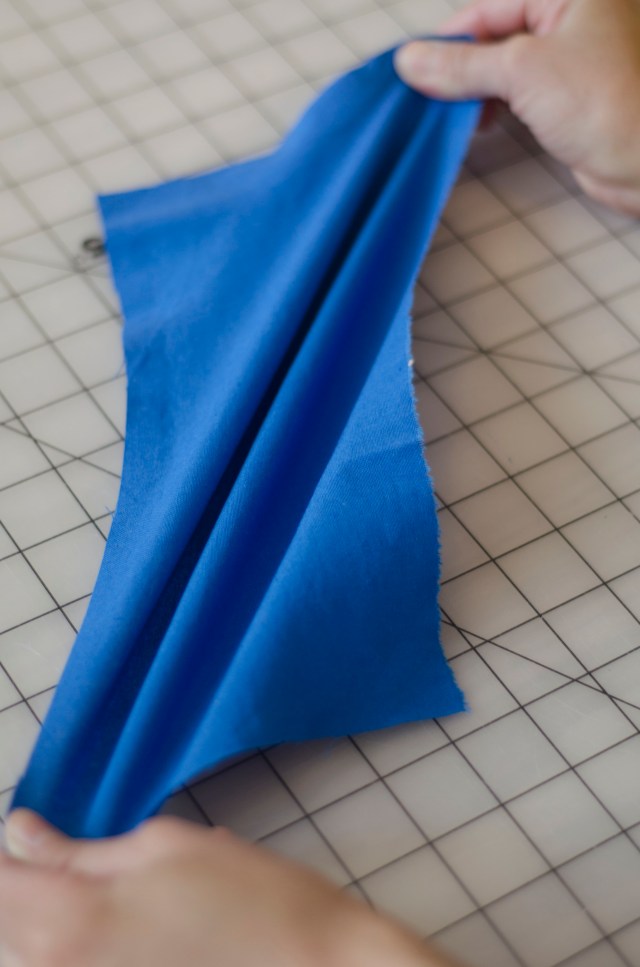
This a woven fabric being stretched on the bias- it doesn’t have much stretch when pulled straight up and down or from side to side.
Woven fabrics are created by weaving threads together in two intersecting directions called the warp and the weft. An example of clothing made out of woven fabric is a standard button-up shirt with a collar, the kind you would wear under a blazer. These fabrics generally don’t have a lot of give longitudinally or latitudinally, but if you stretch them on the diagonal grain (from one corner edge to the opposite corner edge) you will find a little bit of stretch. This directionality of stretch is called the “bias” and it is often used to affect the way a garment hangs off of the body. Because most woven fabrics don’t have much (if any) stretch aside from the bias, they are used in tandem with design features like darts, gathers, and pleats that help the fabric fit onto the body.
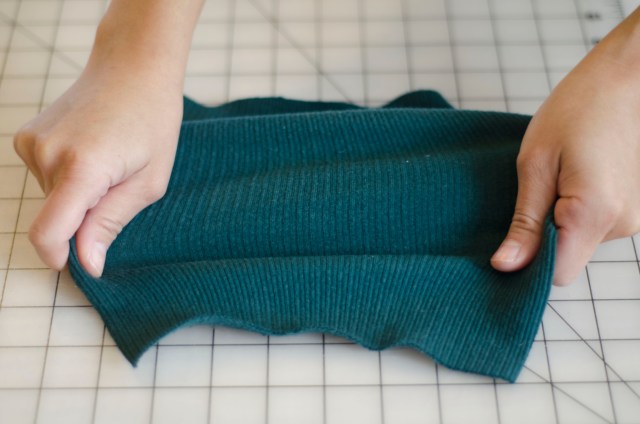
This ribbed knit fabric has a significant amount of stretch when pulled in any direction.
Knit fabric, on the other hand, is comprised of rows of tiny loops of thread hooked through other tiny loops- if you look closely, it resembles the work that you would see on a pair of knitting needles. There is a lot more give with these fabrics and they can be stretched out not only on the bias, but in other directions as well. Many knits are categorized as having 2-way stretch (like a plain t-shirt) or 4-way stretch (yoga pants), and their tensility will depend on what percentage stretch the fabric has.
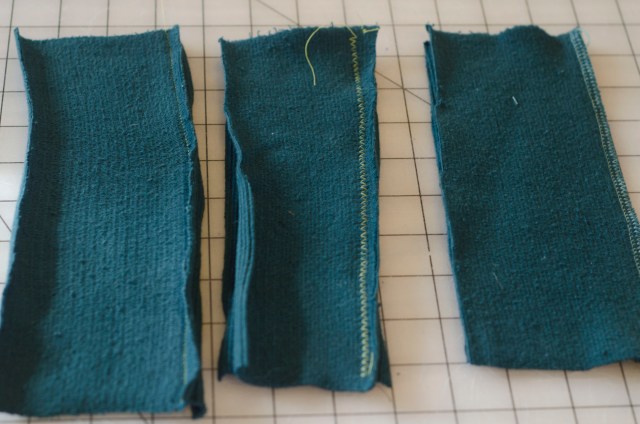
Three different ways to sew knit fabric: from left to right, a straight stitch (not recommended for seams that will need to be stretch out a lot because they may pop open), a zig zag stitch, and a serged seam.
Wovens and knits behave very differently when sewn on a machine. With wovens, you will almost always use a straight stitch to sew your seams together, which will create a sturdy bind that will not easily tear or come undone. But because knit fabrics have so much stretch, you can’t often use a straight stitch to sew it together- the seams will pop open as soon as the fabric is pulled and stretched. This is why a zig zag function is key to sewing knits on a regular sewing machine; the zig zag design allows for the knit fabric to move and stretch on the body while still keeping the seams intact. I personally prefer to use a serger for sewing knit fabrics, a machine that we briefly touched on in the first part of this article. A serger uses a combination of threads to sew flexible seams which allows the fabric to stretch and pull without popping open, and it simultaneously finishes your seams so that you don’t have any raw edges.
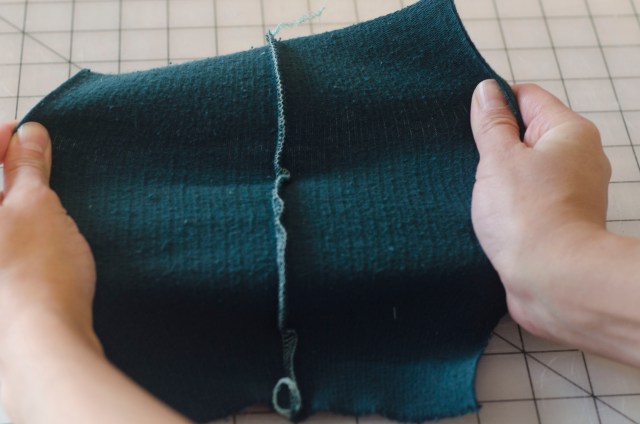
A serged seam is great for knits because it sews the fabric together and trims off the raw edges, reducing bulk and creating a strong, professional finish. You can pull and stretch these seams and they won’t pop open.
Do you NEED to have a serger if you want to start sewing your own clothing? Absolutely not! You can sew virtually any and everything on a regular sewing machine, while a serger on the other hand has a much more limited use. But a serger might be a worthy purchase somewhere down the line if sewing knits becomes a big part of your routine. Sewing with knit fabric is awesome because you can create garments in a fraction of the time that it takes to make something out of a woven material, and the reason for this is because wovens require much more fitting adjustments and alterations to fit well on specific bodies. Imagine shopping for a pair of sweatpants versus a pair of jeans. Many of us whose bodies fit into RTW (Ready-To-Wear) standard sizing can go to a store, pick out a pair of sweats within the XXS-XXL range and find something that fits relatively well. But for jeans, the fit needs to be much more specific; they need to match our measurements in the thighs, the waist and the hips, and if you’re anything like me, you usually end up finding something that works in some places but not in others (all my RTW jeans have big waistline gaps in the back).
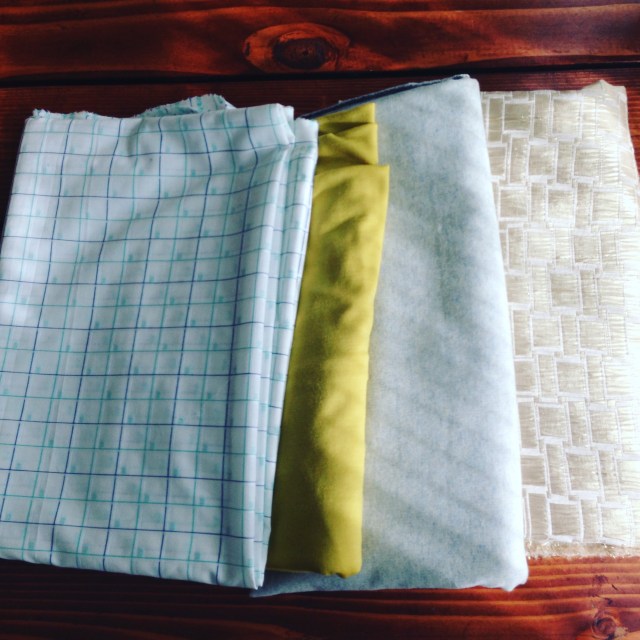
A fabric haul from one of my favorite stores that sources their wool from New Zealand. From left to right, a checkered cotton, a brightly colored knit merino wool, a woven wool blend, and a decorative gold brocade.
The distinction between knits and wovens is only one of many ways to navigate through the big world of fabric, and the more you sew, the more you will figure out what your preferences are. In making decisions about what projects you want to work on, it will also be helpful to have an idea of what kind of qualities you are looking for in your fabric. Do you want your fabric to be cheap? Do you want it to be eco-friendly? Do you want it to be a natural fiber, like silk or bamboo? Do you want to know where it was manufactured? Do you want to buy local? Do you want to buy in bulk? Do you care who made it and how they were compensated for their work?
My own preferences about how and where I buy my fabric has changed a lot over the years, due in no small part to the garment factory collapse in Rana Plaza a few years ago. I was impacted by how tragic the stories of the surviving family members were, and how ashamed I felt about my own culpability as a consumer. Fabric is manufactured in the same way that a lot of RTW clothing is: made in mills that are run by large companies with horrible policies in place for the care and safety of their workers. On top of that, textile production is a huge threat to our ecosystem thanks to the massive amounts of water, toxic dyes and energy consumption it requires. I am not a perfect consumer and not all of my choices for buying fabric are made with these global implications prioritized, but I try to be thoughtful and honest with myself with every purchase I make, and that has made a big difference in how, when, and where I buy my fabric.
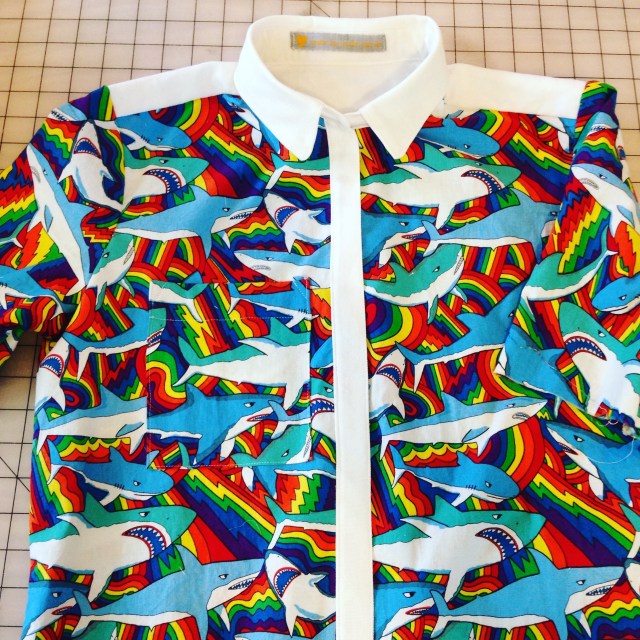
This shark and rainbows short sleeve button down was made for my wife, Claire, and it is always a conversation starter.
Shopping at local and independently owned shops is my first and favorite choice for purchasing fabric (a bonus is that you can usually get on-site information about where the merchandise has come from if that is important to you), but there are also a lot of great indie online fabric stores like hartsfabric.com, hawthornethreads.com, lafinchfabrics.com, hellgatesfabric.com, girlcharlee.com, organiccottonplus.com, lowpricefabric.com and thefabricstore.com. Etsy.com also has a growing number of fabric retailers from all over the world (Miss Matabi is a personal favorite) where you can find unique prints and organic/eco-friendly textiles. There are probably hundreds more reputable sites selling fabric that I don’t even know about, so let google be your friend here! Fabric.com and Joanne’s Fabric are two larger, more well known fabric retailers that offer a lot of choices (online and in-store, respectively). There’s also the wildly popular Mood Fabrics, which carries a lot of amazing choices, but who I have had several frustrating exchanges with due to their poor customer service. When learning how to sew, it’s understandable to not want to spend a lot of money on fabric that will be surrendered to your learning curve, and I have found that searching through thrift stores for old sheets and tablecloths is a great way to get big pieces of fabric for a small amount of money. I use old sheets as muslins for working on fitting and alterations on new patterns, and I once made a really cute dress out of a floral duvet cover that I bought for $1.50. Curtains are another option to thrift for your sewing needs, but be aware that many window coverings are treated with a fire resistant chemical and that might not be the sort of thing you want to wear next to your skin.
Finally, another really fun way to buy fabric is to design your own! An online company called Spoonflower takes your original graphic and puts it onto fabric which you can then buy by the yard. It can be pricey but the quality is decent, and you can choose the layout and type of fabric you want (they carry everything from lycra, which is a type of swimsuit fabric, to organic cotton).
Patterns
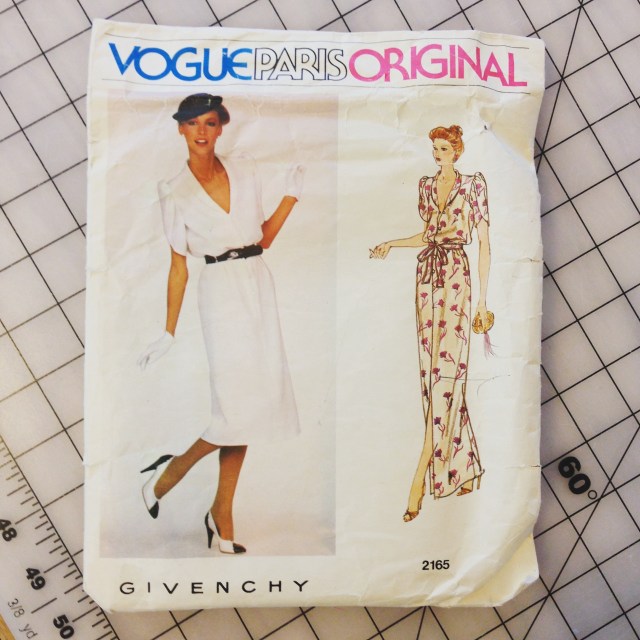
A vintage Vogue pattern by designer Givenchy; I recently wore this dress to a fundraiser.
The phrase “Big Four” refers to the four companies that have dominated the sewing pattern industry for over a century, and you can find them in nearly any big retail fabric store. While McCalls, Butterick, Simplicity and Vogue have historically been known as the biggest game changer for the at-home sewist, providing the first graded patterns to fit a multitude of sizes and shapes that one could sew on a regular sewing machine, it is the advent of the internet that has elevated the modern pattern industry and provided the next big surge of momentum for the sewing community.
Now, online entities are able to virtually create and share sewing patterns by formatting them so that they can be printed out on home printers and pieced together to create full scale pattern sheets. All kinds of contributors, from large companies to independent blogger-cum-designers, are able to create content, share their patterns and gain a solid following of customers thanks to the direct access the internet gives them. The Big Four companies once had a monopoly on the sewing pattern industry, but now the wealth is being more evenly distributed, which has raised the bar for the quality and types of designs available, as well as making sewing more accessible to a broader range of individuals. Jenny of cashmerette.com, a popular sewing blogger, started her own line of sewing patterns this past year, and it is the first ever designed specifically for curvy/plus-sized bodies. Heather Lou of closetcasefiles.com designed a skinny jeans pattern that took the sewing community by storm, introducing lot’s of sewists to successful pants-making for the first time. Taylor of taylortailor.com introduced his first pattern for purchase, a rolltop backpack, to critical acclaim, and recently Colette Patterns launched Seamwork, an online magazine that sewists can subscribe to to read thoughtful articles written by members of the sewing community; subscribers also receive two easy-to-sew patterns (they can be made in three hours or less) every month in their email inbox.
A well known fact of buying Big Four patterns is that you almost never have to pay full price for them — they are more often than not on sale at retail stores like Joanne’s and Michael Levine’s, and Joanne’s is also famous for offering 40% off coupons which makes the discounts even deeper. For this reason, indie patterns tend to be more expensive than Big Four patterns; depending on whether you purchase them as a PDF or a printed pattern, they can run anywhere from $12-$20. To me, the cost is totally worthwhile: it’s the price you pay for supporting an independent artist as opposed to something mass-produced by a large corporation, and in my experience, indie designers offer much more effective sizing than the Big 4 companies, whose measurements are generally understood as being at least one or two sizes bigger than advertised. But even more importantly, many indie pattern designers offer sew-alongs on their blogs to accompany their pattern releases, which is usually a multi-day event that takes the maker step-by-step through the pattern instructions using photographs, videos and question/answer sections. In addition, sew-alongs usually offer information on what kind of fabrics, tools and notions should be used and ideas on where to purchase them. Sew-alongs have become an invaluable aspect of being a member of the online sewing community, and they can provide insight for even the most novice seamster.
Resources
Individuals who begin learning how to sew during this day and age are very lucky; the wealth of information that exists for free on the internet is mind-boggling! And as we discussed before, the internet has given voices to lots of creatives around the world who would otherwise never have had an audience with which to share their work and know-how. Many blogger-cum-pattern-designers have written books with accompanying patterns that include a wealth of information for seamsters about sewing techniques and methods. Gertie’s New Book for Better Sewing is one of my favorites because it breaks down a lot of complicated vintage and couture techniques for the home sewer. This book is, in my opinion, better suited for people who are already familiar with sewing and looking to expand their knowledge or brush up on old skills, but a book like The Great British Sewing Bee, inspired by the popular TV show, is a good start for people who are completely new to the craft, breaking down all the necessary parts of sewing into easily understood chunks. For learning to work with knits, which, as mentioned previously, is much different than working with wovens, I found that The Colette Guide To Sewing Knits was an indispensable how-to guide. It provides detailed information on why knits work the way they do, the differences between various fabric blends and types of knits, and how to use them in tandem with assorted projects and machines.
There are hundreds of other fantastic books available to help you learn to sew and/or get better at sewing, but if books aren’t your thing there are also video tutorials and online classes. Youtube is excellent for looking up specific information and approaches (for example, how to thread a sewing machine), but if you want something more comprehensive, sites like Craftsy.com offer loads of classes for reasonable prices on everything from ‘learning how to sew’ for beginners to ‘drafting your own sloper’ for advanced seamsters. Incredibly gifted teachers from all over the world can access an eager student base via Craftsy’s unique platform, and it gives students the ability to stop and start the class at their leisure. Independent and big-box fabric stores alike also offer sewing classes to the public if your prefer your learning environment to be more hands-on, and if you are unfamiliar with what is available in your area, just do some google searching; there are wonderful indie fabric shops and sewing studios popping up all over the place that offer lots of educational tools for new seamsters.
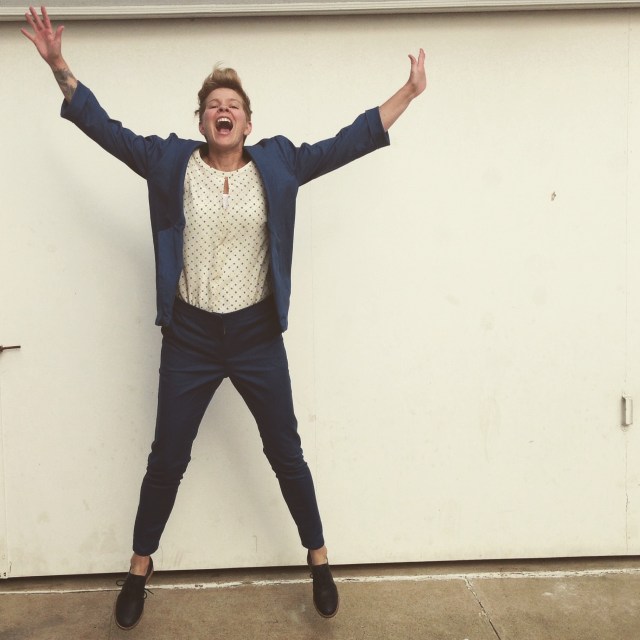
I made this suit for Claire to wear to a wedding she was attending; she has always had trouble finding suits that fit both her body and style, so I tried my hand at making one for her- I still have a lot to learn about tailoring techniques, but I think she looks fantastic in this ensemble!
Finally, for some general inspiration, check out Seamwork Radio started by Colette Patterns, a podcast that tells personal stories of how sewing has influenced and guided the lives of different people across the globe. The stories are always honest, relatable and thoughtful, and I love hearing about how this age-old craft cuts across across different cultures. And then there’s the brilliant missive written by Heather Lou urging us to JUST MAKE IT, ALREADY and stop procrastinating and worrying whether or not our creations will be perfect. I also loved reading this candid post by blogger Marie from A Stitching Odyssey where she talks about her partner recently coming out as trans. I don’t know much more about their journey as a couple other than what is posted on her blog and instagram, but my heart swelled up reading the sewing community’s comments on her post; there seems to have been an outpouring of love, support and respect from friends and strangers alike, which is so rare on the internet.
For me, there is nothing more gratifying than recognizing the ways in which my various identities and interests intersect, and I hope I continue to learn about more non-traditional stories within the sewing community, be they centered on queerness, non-conforming body types and gender identities, differently abled individuals, or all the above. And this brings me to one of the most wonderful things that I have discovered about this special craft: sewing is empowering! To feel proud of one’s body and style, no matter how much or how little it complies with society’s standards, is an act of courage in and of itself. Sewing allows you to create what it is you want to see in the world, one stitch at a time, and it isn’t just limited to clothing: you can make scarves, bags, slippers, head wraps, toys, purses, quilts, pillows, curtains, towels, bowties, bibs, napkins, all decked out in unicorns and rainbows if you’d like, catered to your own personal sensibilities and made to fit whatever space you need it to.
You don’t have to start out big or bold. You can start out with a tiny scrap of fabric, folded and sewn down the edges, to make a little handkerchief. I guarantee you that every time you use it, you will be reminded of how capable you are, how your vision can be manifested into something tangible and functional, how soft and lovely your nose feels after you blow it. Maybe this handkerchief will be all you create, and that will be enough. Or maybe, just maybe, this will only be the start…

I am so grateful for this series! I bought my first sewing machine last month and am now enamored with the craft. Thanks for your insight and expertise!
This is all incredibly informative! There’s so much information about fabrics and sewing online, it can sometimes be overwhelming to sort through. Now if only I had more free time to take on a sewing hobby.
This was so great! I especially appreciated the thorough explanation about knit vs. woven fabrics. I sorta-kinda-maybe knew the difference, but this really clarified things for me!
I recently attended a sewing circle run by an organisation I work for. It’s a free group run by a super talented seamstress at a community centre. I have only been once so far but it’s a lot of fun. The last time I touched a sewing machine was in home ec in high school and I Absolutely Hated It. It was stressful and I rebelled against doing “girly” tasks. Now I’m all growed up and decided this is the year I want to learn to sew. So this is perfect encouragement on my favourite website <3 keep up the awesome work!
Sewing with patterns and machines makes me so anxious I can’t do it, but I have a cool thing to share about freezer paper that could benefit if you’re making, up sizing or even reusing a pattern. If you have a spatially aware mind you can figure it comes in a good size for tracing patterns onto.
However did ya know you can make freezer paper stick to fabric using an iron? Just put the waxy shiny side down on the cloth with the papery non-waz side up and just iron, no pins necessary. It’s not a sticker-like adhesion, it’s more like a static cling without the static.
I learned this from the “town seamstress” at the Ozark cultural center and it’s a thing quilters seem to know about. She said she uses freezer paper alot as she uses historical patterns and uses some specific ones many, many, many times.
So happy to see that Autostraddle is doing a series on this! I get tired of sewing blogs by Mormon housewives that only make stuff for their babies and husbands…
Cant wait for the next post!
I am really grateful and looking forward to reading this! My head isn’t in a space to be reading anything but more than a sentence right now but just letting you know THANK YOUUUU in advance.
Thank you for this! The links are so helpful. When I buy clothes RTW I struggle with my proportions not fitting the standard sizes (I’ll spare you the details). I’m psyched to learn there is a plus size, Indie source for patterns. And who knew there are online resources to help you complete a project? I’m inspired try making clothes for myself again! Can’t wait for more on this topic. I LOVE the photos of completed sewing projects and encourage others to share in their comments as well.
I never can tell what a pattern will look like in the real world, but I like to make garments by copying something I’ve already got. Yes, I have boring and repetitive tastes in clothing. But it works for me to trace the outlines of something I’m already happy to be wearing, and use that for my pattern. I mostly wear knits.
Part 1 of this series helped me understand the many feet my old sewing machine came with, and I’m very grateful for that! I make simple patchwork quilts with scrap fabric, and getting over the thick layers is always the hardest part of the whole operation.
Thanks for ideas on where to get supplies, too! One can only spend so many hours with a search engine before getting fed up. It’s good to have advice on places to go directly.
i have been sewing for 50 years and enjoy it…I do a lot of it by hand. i also quilt, knit and crochet….. after reading 2 of your articles i realize that there is always something new to learn… i am looking forward to reading the remaining 2 articles… thanks you for writing and sharing such insiteful articles…
Thanks so much, Carol- I am so glad I could provide a little info and inspo for a well-seasoned sewist! There are only two articles in this series and they have both been posted already, so there won’t be any more coming up, but I do hope to write more about sewing and crafting in the future. A-straddlers, if there is anything specific you would like to see here or learn more about, please let us know and I will see if I can deliver!
This is a great article, that I really enjoyed reading. Thanks for sharing.
I have a sewing machine, but have only made flat and square things. I’ve got fabric and I’ve got patterns, but I feel like I have no idea how to use the patterns? I’d love some advice on how to use a pattern!
Thank you so much for posting this article! I am hoping to make a short sleeve button-up for my partner for their birthday and I love the one that you made your wife! Where did you get the pattern from? Everywhere I look for button-up shirt patterns they are either sized for men or too femininely tailored. Any suggestions would be much appreciated!
It’s the Archer Button Up pattern by grainline studios :)